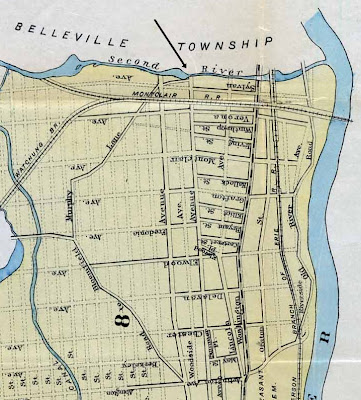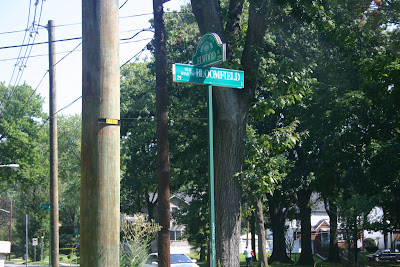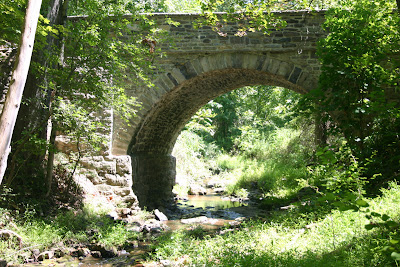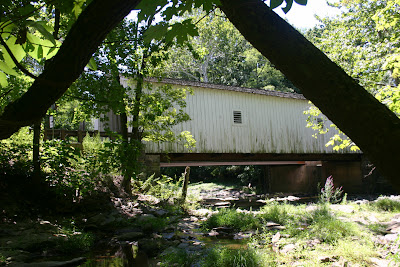Scary bridge.
Central Avenue over City Subway
— Status
Open to traffic
— History
Built 1908
— Design
Pony truss
— Dimensions
Length of largest span: 112.9 ft.
Total length: 118.1 ft.
Deck width: 47.2 ft.
— Inspection (as of 09/2008)
Deck condition rating: Fair (5 out of 9)
Superstructure condition rating: Poor (4 out of 9)
Substructure condition rating: Fair (5 out of 9)
Appraisal: Structurally deficient
Sufficiency rating: 49.4 (out of 100)
Structurally deficient.
I've gone under the Central Avenue Bridge a few dozen times on what is now called the Newark Light Rail line, and a couple of weeks ago I went over it.
Some interesting things about this bridge.
First, the angle of crossing is extremely skewed. Going along Central Avenue, you pass one steel truss on the left, then go through an intersection, and then pass the other truss on the right. See the aerial view from Bing below.
Second, the south side is really three trusses in a row, while the north side is just one.
Third, when built in 1908 it crossed over a canal, not a rail line. This is the only bridge over the city subway that was not built new when the subway was constructed.
I wanted to know how such a awkward bridge came to be built and why it's still there.
The Morris Canal was completed from Newark to Phillipsburg in 1831. Crossing New Jersey involves a lot of hill climbing, and the canal used 34 locks and 23 inclined planes. The planes carried the boats on cradles running on rails. The location at Central Avenue was close to the upper side of Lock 16 East (marked today by Lock St, near Warren St), and there was a widened basin in the area for boats waiting to lock through.
Central Avenue came later.
Below is a portion of a street map from 1853, which I annotated to show the future location of Central Avenue. If the drawing is accurate, no streets bridged the canal between New Street (at Lock Street) and Sussex Avenue.
This explains a lot. If Central Avenue had existed when the canal was built, they probably would have tried to avoid such a skewed crossing. Instead, Central Avenue was cut through later. Its width and almost straight path from Broad Street to the city line suggests some degree of dramatic gesture was involved, and therefore its unfortunate angle of crossing the canal simply had to be dealt with.
Central Avenue is not on a map from 1872, but does appear on a map from 1881. Therefore the structurally deficient bridge we have today replaced another one after roughly 30 years.
The first bridge was evidently strong enough to support a street railway. The Central Avenue cars began running in 1890.
Below is part of a plate from an 1892 real estate atlas. The south side of the implied bridge is shown as running from Jay Street to just east of Hudson Street, exactly like the existing bridge. The canal is not shown emerging on the north side of Central Avenue just west of Hudson, but the angles of the buildings imply that it did. The purpose of these maps was to show properties and buildings, so the depictions of other features like canals are not always precise. Most of the buildings shown are wooden, shown yellow, but a few are brick, shown pink.
The only slight detail I could find about the first bridge is in John Harrington Riley's very detailed chronology The Newark City Subway Lines (the author, 1987), where he writes:
On March 1, 1908 the Morris Canal Bridge on Central Avenue in Newark was closed as unsafe. While the new bridge was being built the Central cars were re-routed [...]. At 8:30 a.m. on Thursday, May 28, 1908 the Central cars reverted to their regular route via Central Avenue over the new canal bridge.
Below are parts of two plates from a 1908 real estate atlas that show the new bridge. (The atlas has a page break at Central Avenue, and the two don't quite line up, so I have just copied in the two parts.)
This atlas shows better than anything I've seen how the canal crossed under the street, and it provides a clue to how the bridge works.
On the southern side, there were two support columns shown by squares, with beams running across the canal to the masonry wall on the north side of the canal, under the road. This explains very well why there are three truss structures along the south side.
I made a diagram:
Span A rests on the north side truss (dark blue), the south masonry wall (brown), and a cross beam.
Span B has no truss, resting on the two masonry walls and two cross beams.
Spans C, D, E, rest on the north masonry wall, three trusses, and two cross beams. The cross beams originally extended beyond the trusses to reach masonry columns on the south side of the canal. During construction of the subway, new columns were placed directly under the ends of the trusses and the outer part of the beams cut out.
Here is what it looked like.
The Morris Canal was closed in 1924. The photograph above shows the view from Norfolk Street after it was drained. The occasion might be the date in 1929 when the City of Newark contracted to build a trolley rapid transit line in the canal bed.
You can see the three trusses along the south side of Central Avenue, and one of the cross beams, the other hidden behind it from this angle. You can also see that depositing junk into abandoned property is not a new thing in Newark.
The subway opened in 1935. Originally subway services resembled the trolley subways now running in Boston, Philadelphia, and San Francisco: cars ran out of the subway into street railways. The Central Avenue car line was one of those routed into the subway. Ramps were built that can be seen in the 1955 photo below, taken from under Norfolk Street bridge.
Photo by Frank Pfuhler, as seen on David Pirmann's nycsubway.org site. Inbound Central Avenue cars left the street at Hudson Street and came down ramp seen on the left. Outbound cars went up the ramp on the right and crossed over the subway on a new bridge that rose alongside the Central Avenue Bridge. Central Avenue cars stopped running in December 1947, but as you can see the ramps were still there eight years later (and many years more).
In August 2011 I took the view below from Norfolk Street bridge, from an angle similar to the 1920s photograph. The remains of the ramps are still there, but the track bridge was removed a long time ago now.
I'm sorry there is a chain-link fence everywhere you turn here. This is just about the best view you can get now from street level.
On a much earlier occasion, Sidney Selleck Jr snapped the view from the other direction, looking down the ramps. (Dot screen courtesy of its publication in Traction Extra number 1, The City Subway / Newark's Best Kept Secret, by Joseph Saitta (Merrick NY: Traction Slides International, 1985).)
Those are new cross beams, not the old ones, holding up the track bridge, and I think they were not connected to the Central Avenue Bridge. The date here seems to be in the 1935-1947 era when the ramps were in use.
Below, my very sorry attempt to get a similar point of view in August 2011. Note the very end of the pipe railing that once continued onto the track bridge.
Check the fine rust detailing on the rest of the steel. Note: this is not one of those modern buildings where the rust is intentional and makes it stronger. No.
I have worse photographs. Let me try your patience a little longer.
This happens to show two details well. First, see the support column under the ends of the trusses. On top of it is a support pole for trolley wire that really could have been removed. If you look near the left, another pole marks the location of the other support column. Second, under the bridge you can see a little of the masonry side wall. The white on the stone is some mixture of graffiti and pigeon droppings.
The photo below looks across Central Avenue from the north side. The crack in the sidewalk running out into the street shows the angle of the north side of the masonry wall as it crosses the north side of Central Avenue. The wall curves left as it goes.
I could not get a good photo of the north side truss. It's covered in chain-link fence, and the possible view from the next bridge, corner of Duryea and Dickerson, is totally obscured by a dense growth of ivy on another chain-link fence. But you can guess what it looks like. Rust.
Should this bridge be preserved? No. Let's replace it. If the City of Newark can't afford to replace it, let's at least remove it, while we can choose how to do it, not after it has fallen onto the tracks. We might be able to live without it. I don't know the politics involved, but that's midday weekday traffic you see there in the photo. The bridge is scary.
.






































